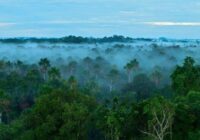A proposed amendment to Brazil's constitution threatens forests and indigenous rights.
On April 16, 2013, the chanting of hundreds of citizens and the rattling of maracas flooded the Chamber of Deputies, the lower house of the Brazilian National Congress. Traditionally dressed members of 70 indigenous tribes, who had congregated for an annual meeting, staged a sit-in of Congress to protest a proposed amendment to the constitution (PEC 215). PEC 215, if passed, would threaten not only indigenous land rights, but also the conservation of the Amazon rainforest.
The 500-year-old history of indigenous rights in Brazil is extremely complex. But a lucid reality remains: indigenous lands are “the most important barrier to Amazon deforestation,” according to a breakthrough 2006 study that compared the conservation value of indigenous lands and national parks.
Researchers, including Jose Fragoso of Stanford University, are now discovering why and how this phenomenon persists. The study comes at a time when proposed changes threaten to undercut Brazil’s system of indigenous land demarcation.
In recent decades, the National Indian Foundation (FUNAI) within Brazil’s Department of Justice has been charged with the duty of discovering traditional "Indian" homesteads and returning exclusive ownership of those lands to natives. In addition to honoring rights that are recognized internationally but violated in many countries, the demarcation of indigenous territory has proven vital to the preservation of both native culture and forest ecosystems in the Amazon.
Now, as just one component of a series of changes sweeping Brazil, President Dilma Rousseff is heeding the demands of right-wing farmers and aiming to transfer authority over the land demarcation process from FUNAI to Congress. Opponents of the bill argue that the change would effectively stop further demarcation of indigenous territories, because Congress is so heavily controlled by agricultural special interests.
“In Congress, farmers have much more support than the Indians right now,” said Marcelo Leite, a Brazilian journalist who specializes in indigenous issues. Because of the clout of agribusiness in Congress, “most people that are dealing with indigenous peoples’ issues in Brazil fear that if this bill is approved, it would make it very hard for indigenous people to get approval for new Indian territory.”
Jose Fragoso, a Brazilian senior scientist in the Biology Department at Stanford University, shares Leite’s concerns. In the current practice of demarcating lands, experts in anthropology and history give priority to indigenous people, regardless of how lucrative the land may be. But “in the new approach they want to include people who are more concerned with land development, whether for mining, agriculture or dams, to have the final say,” said Fragoso. “These special interests have a lot of power and a lot of lobbyists in Congress. Congress tends to represent those who have land or have great wealth.”
A Threat to Indigenous Brazilians
The traditional land demarcation process carried out by FUNAI and approved by the president has been arguably successful in social and environmental metrics. Currently, indigenous territories comprise of 13 percent of Brazil’s total land area, and are home to 560,000 people. Indigenous lands help native cultures and languages survive, a feat that is nearly impossible to achieve outside of demarcated territories.
Leite cites PEC 215 as the biggest threat that indigenous Brazilians face today. “Parts of the government, and a big constituency in Congress, are trying to prevent some of the remaining nations that haven’t had their land recognized from having it,” he said. “This is the most important threat.” While 60 percent of indigenous people live in the Amazon, conditions can be harsh for the remaining 40 percent.
Indians who live outside indigenous lands often face discrimination and poor labor conditions, and suffer higher rates of depression, alcoholism and suicide. In the savannah and Atlantic forest of southern Brazil, for example, “Indians are having a much more difficult time because they are small populations. Traditional ways of life are getting lost by the people, [including] languages,” said Leite. “Maybe they’re selling arrows on the side of the road, or selling hearts of palm. This is the difficult situation for many Indians in this part of Brazil. They are very, very poor and very discriminated against.”
Preserving Biodiversity
As Brazil becomes an increasingly important player in the global markets for soy and sugar, the political atmosphere of the country is shifting increasingly toward a heightened emphasis on economic growth. One way that President Rousseff is pursuing economic growth is by sympathizing with a right-wing organization of farmers and activists that Fragoso compares to the Tea Party in the US. These ruralistas, as they are known, are gaining traction and pushing hard to reclaim priority over Brazil’s most fertile lands. Perhaps unsurprisingly, they are also the reason why PEC 215 was proposed.
Though Rousseff and her predecessor, Luis Inácio Lula da Silva, both belong to the Workers’ Party, their platforms and priorities are divergent in many ways. While da Silva aimed to improve social conditions in Brazil by reducing income inequality and alleviating hunger and illiteracy, Rousseff has focused so far on economic growth through large-scale infrastructure projects and agricultural development. Da Silva viewed progress through the lens of quality of life and equality, while Rousseff emphasizes GDP growth and exports.
But allocating more land to soy production, mining and other types of development, instead of to indigenous lands, will not come without costs, especially for natives. While GDP has grown 14.6 percent since Rousseff came to office, there has been no corresponding reduction in the stark income inequality that has plagued Brazil for centuries. With about 40 percent of indigenous people living in poverty, native communities fare the worst financially of any racial group in the country.
PEC 215 wouldn't just prevent good stewards from protecting more biodiversity-rich forest, it would turn those areas over to agriculture, ranching or mining to be cleared for energy-intensive uses. Such projects, meant to promote economic growth, benefit only the elite minority, while masses of poor farmers and indigenous people are pushed deeper into poverty, with their land desecrated.
“The benefits of soy go to the people who own the land,” said Fragoso, who just returned from a research trip in the soy fields of Mato Grosso. In exchange for clearing vast expanses of forest and kicking thousands of people off their land, the consolidation of agriculture “improves exports, and increases the GDP of the country. But it actually doesn’t benefit people at the bottom rung of society.” According to Fragoso, the Amazon is not an ideal place to grow soy, but with substantial input of chemical fertilizers and pesticides, capitalized farmers can change the soil chemistry enough to make it work.
With so many encroachments on and around land occupied by natives, many fear that PEC 215 will degrade biodiversity in the Amazon and indigenous quality of life even further by legalizing what is already happening in many places: the loss of indigenous land to farming and industrial projects.
“The government’s strategy against indigenous people,” said Fragoso, “is a continuation of large infrastructure projects and agro-industrial projects, and allowing farmers to have a say of whether areas are designated indigenous areas.”
After reaching an all-time high in 2008, deforestation rates in the Amazon began a steady decline. This progress can be traced to government initiatives like satellite forest monitoring, improved law enforcement, and expansion of protected areas and indigenous lands. But despite concerted efforts to crack down on rampant deforestation, biodiversity continues to be threatened by ranching, commercial agriculture, road development, logging, hydroelectric projects, mining, and illegal settlements.
Beyond the violation of constitutionally protected rights, the success of PEC 215 could also cause a cascade of environmental consequences in a country that was finally beginning to turn the tide on rapid destruction of its rainforest. According to Vasco van Roosmalen, a political scientist and the director of ECAM, an NGO that helps indigenous people manage and protect their territories, indigenous land rights are absolutely critical for the protection of biodiversity and forest cover.
“Indigenous lands occupy over 20 percent of the Brazilian Amazon and are some of the most isolated, preserved swaths of rainforests,” he added. “They also act as corridors of protected forests in the arc of deforestation. Their role in maintaining public ecosystem services is unquestionable, as well as providing quality of life for the people who live in these regions.”
The creation of uninhabited national parks is one way to preserve biodiversity. But research has shown that indigenous lands are at least as successful, if not more so, at preserving forest cover. Daniel Nepstad, a tropical forest ecologist and the co-founder of the Amazon Institute of Environmental Studies, conducted a study in 2006 comparing the effectiveness of national parks and indigenous lands as conservation tools in Brazil. He concluded that indigenous lands are the most effective tool against continued deforestation in the Amazon, because they act as a barrier against frontier expansion deeper into the forest.
Nepstad’s study also concluded that a broad base of political support would be necessary to tap into indigenous lands as a conservation tool — political support that now appears to be slipping away.
“It’s amazing. You can really see it, a big chunk of green and then lots of deforestation around it, mainly because of cattle and soybean,” said Leite. “As a general rule, in indigenous lands, especially in the Amazon, the forest is much more intact, so greater biodiversity is thriving, than in the adjacent farmland.”
“Indigenous people have played an important part in maintaining forests and biological diversity,” said van Roosmalen. “One only needs to go on Google Earth to see the result of this protection versus the surrounding areas.”
Fragoso’s recent work builds on the research conducted by Nepstad, and begins to explain why indigenous lands retain a higher percentage of forest cover than their surroundings. While the studies have yet to be replicated in Brazil, he has done extensive research in Guyana, which is home to many of the same tribes. His work showed that indigenous peoples’ sustainable hunting practices — which appear to be influenced by spiritual beliefs and dietary taboos — allow for flourishing game populations.
“It all has to do with their religion,” Fragoso argues. “Their religion is such that they’re very closely tied to plants, animals, mountains, rivers. They can’t consider themselves without considering these things. That would be sort of like considering yourself Christian, but not considering Jesus Christ.”
The Outlook
It remains to be seen whether PEC 215 will find its way into the constitution, or whether the voices of indigenous people and environmentalists will be enough to remove the bill from the table. For now, the demarcation process is suspended until a committee is established to review the bill. But just because the government isn’t doing anything, “that doesn’t mean nothing is happening,” said Fragoso. “Everyone is behind the scenes rearming and reorganizing; the issue hasn’t gone away.”
Meanwhile, tension is certainly escalating. In May, an indigenous leader of the Terena tribe was killed in a violent encounter with farmers over the Biruti Indigenous Land in the southern state of Mato Grosso do Sul. And in June, farmers staged a protest over the creation of a new Indian reserve in Rio Grande do Sul, the Mato Preto Indian Reservation. The protest covered 4,200 acres and spanned the property of 380 farming families.
“The situation right now is not in favor of indigenous rights in Brazil,” observed Leite. “I’m not very optimistic about it.”
Whether PEC 215 succeeds or not, van Roosmalen and other opponents of the bill are concerned about the broader tapestry of changes occurring in Brazil, of which this policy debate is just one patch.
“It is not so much the change in the demarcation process by itself,” van Roosmalen began. The change must be viewed within the context of the myriad ways the forest is under attack, including mining, logging, commercial agriculture, and infrastructure development. “All of this together forms a trend of weakening of the instruments to properly maintain, manage and protect these forests, their cultural and biological diversity.”
“Economic growth cannot just be based on GDP and large infrastructure projects,” van Roosmalen continued. “It needs to take into account quality of life and the sustainability of our society within the larger context of our environment and the ecosystems of which we are all a part.”
The views expressed in this article are the author's own and do not necessarily reflect Fair Observer’s editorial policy.
Image: Copyright © Shutterstock. All Rights Reserved
Support Fair Observer
We rely on your support for our independence, diversity and quality.
For more than 10 years, Fair Observer has been free, fair and independent. No billionaire owns us, no advertisers control us. We are a reader-supported nonprofit. Unlike many other publications, we keep our content free for readers regardless of where they live or whether they can afford to pay. We have no paywalls and no ads.
In the post-truth era of fake news, echo chambers and filter bubbles, we publish a plurality of perspectives from around the world. Anyone can publish with us, but everyone goes through a rigorous editorial process. So, you get fact-checked, well-reasoned content instead of noise.
We publish 2,500+ voices from 90+ countries. We also conduct education and training programs
on subjects ranging from digital media and journalism to writing and critical thinking. This
doesn’t come cheap. Servers, editors, trainers and web developers cost
money.
Please consider supporting us on a regular basis as a recurring donor or a
sustaining member.
Will you support FO’s journalism?
We rely on your support for our independence, diversity and quality.






Comment